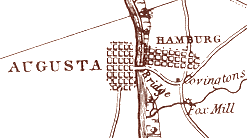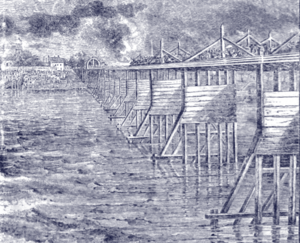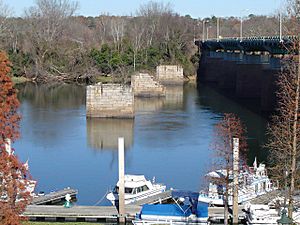Hamburg, South Carolina facts for kids
Hamburg was once a busy town in Aiken County, South Carolina, United States. It is now a ghost town. It was located across the Savannah River from Augusta, Georgia. Henry Shultz founded Hamburg in 1821. He named it after his hometown in Germany.
By the 1830s, Hamburg became one of South Carolina's main trading centers. This was because the South Carolina Canal and Rail Road Company chose Hamburg as the end point of its railway line to Charleston.
But Hamburg's importance began to fade around 1848. Augusta built the Augusta Canal, which took away much of Hamburg's river trade. The town's decline was complete by the 1850s. This happened when the South Carolina Rail Road extended its line directly into Augusta.
After the American Civil War, many freedmen (formerly enslaved people) moved to Hamburg. In 1876, the town became known for a sad event called the Hamburg Massacre. This was when white groups attacked Black residents. It was part of a larger effort by some political groups to stop Black people from voting. After this, federal troops left South Carolina, ending the Reconstruction era.
Contents
History of Hamburg, South Carolina

How Hamburg Was Founded
Henry Shultz, the founder of Hamburg, was born in Germany in 1776. His original name was Klaus Hinrich Klahn. He came to Augusta in 1806 as a simple worker. By 1813, Shultz had become successful. He was able to build a strong bridge across the Savannah River. This was a big achievement. Even a wealthy person named Wade Hampton I had failed to build a bridge twice before.
Shultz became an important person in Augusta. He owned part of a steamboat company and a dock. But like many bank owners in the 1810s, Shultz's bank failed. This happened during a financial crisis in 1819. He was sued by people he owed money to. Georgia officials then took his Augusta Bridge.
Shultz felt unfairly treated by Augusta. So, he bought land across the Savannah River. This land used to belong to Chickasaw Native Americans. He wanted to create a town that would compete with Augusta. The next year, Shultz got loans from the South Carolina General Assembly. These loans helped improve river travel between Hamburg and Charleston. The state also removed taxes on property in Hamburg for five years.
Hamburg's Banks and Trade
Shultz started a second bank, the Bank of Hamburg, in 1823. This bank also failed within two years. Ten years later, a new bank was started with state support. This second Bank of Hamburg became very well-known. Many families used it to pay for colleges in the North.
The new bank opened as the wagon trade in South Carolina was shrinking. From 1819 to 1823, wagon trade became much smaller. Steamboats became a cheaper way to transport crops. This made towns like Hamburg, Camden, and Columbia important. These towns were located where rivers had waterfalls, which was good for steamboat travel.
In 1825, a famous French general, the Marquis de Lafayette, visited Hamburg. His secretary wrote that Hamburg was a "prodigy." It was "not yet two years old" but its port was "already filled with vessels."
Slave Trading in Hamburg
Slave trading was not allowed in Georgia for a time. Because of this, people who wanted to buy enslaved people would cross the Savannah River to Hamburg. This continued until Georgia changed its law in 1856.
Hamburg's Competition with Augusta
In 1833, the South Carolina Railroad was finished. It was the largest railroad managed by one company in the world at that time. Hamburg became the railroad's western end point.
In its best years, about 60,000 bales of cotton came to Hamburg by wagon each year. This cotton was worth about $2,000,000. But things changed after the Augusta Canal was completed in 1848. Also, more railroads were built in the 1850s. This made long wagon trips to Hamburg unnecessary. The famous wagon traffic decreased. By the time of the American Civil War, Hamburg had become a ghost town.
Hamburg After the Civil War
After the war, Hamburg was rebuilt. Many freedmen moved there and helped govern the town. Important leaders included Prince Rivers, Samuel J. Lee, and Charles D. Hayne. These three men helped create Aiken County. They worked to bring more freedmen to Hamburg. A marker at the Aiken County courthouse celebrates the county's 125th anniversary. It lists Rivers, Hayne, and Lee as founders.
After the Hamburg Massacre on July 8, 1876, the town truly began to decline. Augusta built a river wall after a flood in 1911. But Hamburg remained unprotected. Very bad floods in 1929 finally forced the last residents to leave.
Geography of Hamburg
Hamburg was sometimes spelled Hamburgh. It was named after Henry Shultz's hometown in Germany. It was located at 33.4799°N, 81.9579°W. This is directly across the Savannah River from Augusta, Georgia.
At its busiest in the 1840s, Hamburg had about 2,500 people. In the 1870s, it still had over 1,000 residents. Most of the town was on the flat land near the Savannah River. You could reach the town by a stagecoach road from the Edgefield County Courthouse. Later, the Edgefield and Hamburg Plank Road also led there.
Today, the Clarks Hill Dam and Lake protect the area. North Augusta is now developing on the land where old Hamburg used to be.
Notable People from Hamburg
- James E. Broome, who was the governor of Florida from 1853 to 1857.
- A. Viola Neblett (1842–1897), an activist who worked for women's rights.
- Marcus Junius Parrott, a delegate to the U.S. Congress from Kansas Territory from 1857 to 1861.




